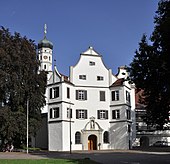St. Magnus (Bad Schussenried)
The parish church of St. Magnus is in the center of Bad Schussenried in Baden-Württemberg .
history
The church was formerly part of the Schussenried monastery and was built in 1185. In the 15th century it was rebuilt and gothicized. The interior was baroque in the 18th century.
Choir stalls
The church has a high baroque, richly decorated choir stalls made of walnut wood, which were created by Georg Anton Machein (1685–1739) and his workshop in 1715–1717 and, like the Buxheim choir stalls, belong to the figuratively decorated group of the "Swabian acanthus choir stalls". In the dorsal fields there are reliefs made of linden wood, the thematic focus of which is on the life of Mary and the Passion of Christ. They are flanked by statuettes of twenty-four male and four female founders of the order. In 1930 the choir stalls were dismantled as part of a renovation and placed closer to the high altar in 1932. The north side was swapped with the south side, so that the chronological order of the relief scenes no longer begins in the west, but in the east. Unfortunately, the woodworm left clearly visible traces in the limewood.
- High altar
| Order founders, saints and relief representations | Choir room | Order founders, saints and relief representations |
|---|---|---|
| Fall into sin with promise of the Savior | Virgin Mary's birth | |
|
Augustine 4th / 5th century
Author of the Rule of Augustine |
Norbert von Xanten 11./12. century
Founder of the Premonstratensian |
|
| Passage to the Temple of Mary | Annunciation | |
|
Paul of Thebes 3rd / 4th centuries century
First hermit, model for the Paulines |
Anthony the Great 3rd / 4th century
Father of western monasticism |
|
| Marriage of Mary to Joseph | Visitation of the Virgin Mary | |
|
Benedict of Nursia 5./6. century
Founder of the Benedictines |
Bernhard von Clairvaux 11./12. century
Important abbot of the Cistercians |
|
| Birth of Christ | Adoration of the three kings | |
|
Francis of Assisi 12./13. century
Founder of the Order of Friars Minor |
Dominic of Caleruega 12./13. century
Founder of the Dominicans |
|
| Presentation of Jesus in the temple | Escape to Egypt | |
|
Basil the Great 4th century
Father of oriental monasticism |
Jerome 4./5. century
Hermit, Doctor of the Church |
|
| The twelve year old Jesus in the temple | Holy Family in Nazareth | |
|
Bruno of Cologne 11./12. century
Founder of the Carthusians |
William of Malavalle 12th century
Hermit, model for the Wilhelmites |
|
| Temptation of christ | Wedding at Cana | |
|
Ignatius of Loyola 15./16. century
Founder of the Jesuits |
Philipp Neri 16th century
Founder of the Oratorians |
|
| Transfiguration of Christ | Jesus said goodbye to Mary | |
|
Petrus de Murrone 13th century
Hermit, founder of the Celestine hermits |
Philip Benitius
13th century Prior General of the Servites |
|
| Christ on the Mount of Olives | Flagellation of Jesus | |
|
Petrus Nolascus 12./13. century
Co-founder of the Mercedarians |
Johannes von Matha 12./13. century
Co-founder of the Trinitarians |
|
| Jesus crowned with thorns | Christ before Pilate | |
|
Franz von Paola 15./16. century
Founder of the Paulaner (Minimen) |
John of God 15./16. century
Model for the Brothers of Mercy |
|
| Jesus carrying the cross | Crucifixion of jesus | |
|
Kajetan von Thiene 15./16. century
Co-founder of the Theatiner |
Johannes Colombini
14th century founder of the Jesuats |
|
| Lamentation of Christ (Pietà) | Burial of Jesus | |
|
Francis of Sales 16./17. century
Co-founder of the Salesians (Visitantinnen) |
Laurentius Justinianus 14./15. century
Founder of the regulated Canons of St. George |
|
| Resurrection of Christ | Ascension of Christ | |
|
Clare of Assisi 12./13. century
Foundress of the Poor Clares |
Teresa of Ávila 16th century
Carmelite reformer |
|
| Sending out the Holy Spirit | Assumption Day | |
|
Birgitta of Sweden 14th century
Founder of the Birgittines |
Joan of France 15./16. century
Founder of the Annunti women |
The inscription "Romuald von Camaldoli" on the choir stalls is wrong, because the figure there undoubtedly represents John of Matha. Teresa of Ávila is given the wrong attribute: the cross with Christ's crown of thorns and the tools of the Passion belongs to Bernhard von Clairvaux.
See also: Table with pictures (Wikimedia Commons)
organ
The organ was built by the company Weigle from Echterdingen in 1978/1979. The organ has 34 stops on 3 manuals and a pedal.
Bells
The parish church currently has six bronze bells from the years 1502. 1721, 1950 and 1951 with the tone sequence of 'f' as 'b' of '' es ''.
literature
- Hubert Kohler (Ed.): Bad Schussenried. History of an Upper Swabian monastery town. Festschrift for the 800th anniversary of the foundation of the Premonstratensian Foundation . Thorbecke, Sigmaringen 1983, ISBN 3-7995-4060-1
- Johannes May: The heavenly library in the Premonstratensian monastery Schussenried (Marbacher Magazin, special issue 87/1999). 2nd Edition. German Schiller Society, Marbach 2000, ISBN 3-933679-27-3
- Sybe Wartena: The South German choir stalls from the Renaissance to Classicism. Munich 2008 (Dissertation at the Ludwig Maximilians University)
- Dr. Otto Beck: Parish Church of St. Magnus (and Maria) Bad Schussenried, Schnell little art guides, Schnell and Steiner, Munich and Zurich
Web links
Individual evidence
- ↑ Dr. Otto Beck: St. Magnus (and Maria) Bad Schussenried . In: Dr. Paul Mai (Ed.): Small art guides . 3. Edition. Schnell and Steiner, Munich and Zurich 1984, ISBN 3-7954-4164-1 , p. 12 .
Coordinates: 48 ° 0 ′ 24.5 ″ N , 9 ° 39 ′ 29.5 ″ E


